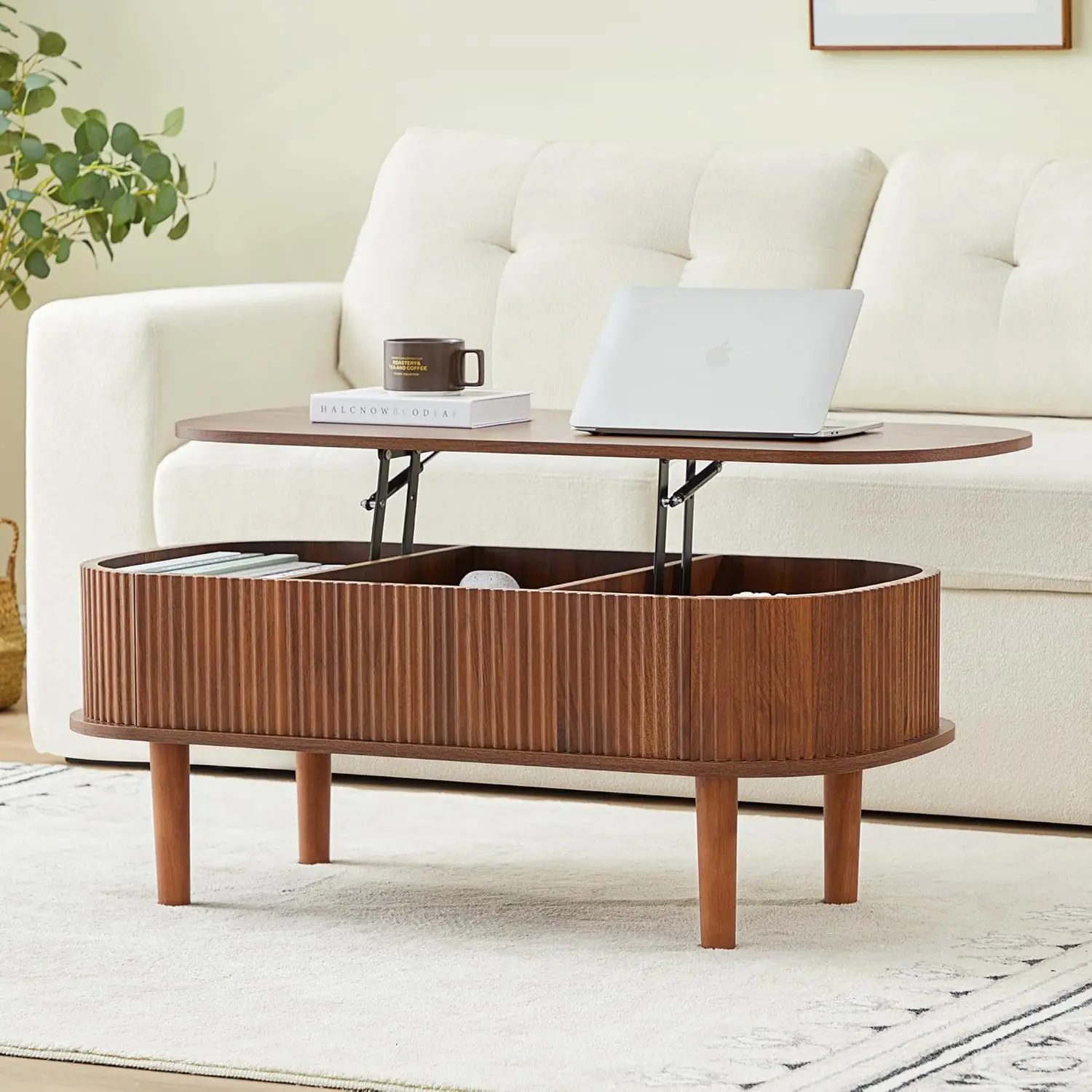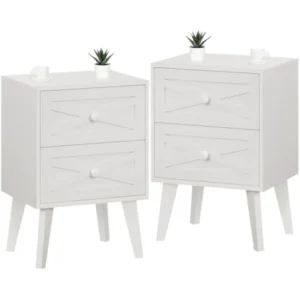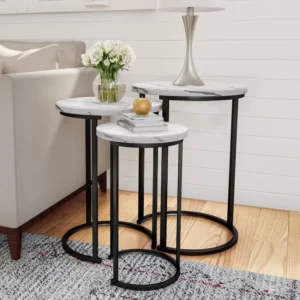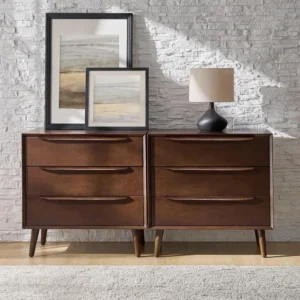Understanding the Essence of Scandinavian Table Design
Scandinavian design has captured hearts worldwide with its perfect balance of beauty and purpose. At its core, this design philosophy embraces minimalism, functionality, and the concept of “hygge” – the Danish word for coziness and comfortable conviviality.
When it comes to table design, Scandinavian principles shine through distinct characteristics:
- Clean lines that avoid unnecessary ornamentation
- Light woods like oak, ash, birch, and pine that bring warmth to spaces
- Neutral color palettes with occasional pops of subtle color
- Natural materials that create connection to the outdoors
- Functionality that never sacrifices form
The “less is more” approach is particularly evident in Scandinavian tables, where each element serves a purpose. Unlike heavily decorated furniture from other design movements, these tables let their materials speak through simple, honest construction and thoughtful proportions.
This design tradition emerged from Nordic countries where long winters necessitated bright, practical interiors. The result was furniture that maximized light, simplified living, and created harmony within the home. Today, these principles make Scandinavian tables ideal for functional living spaces.
The enduring appeal of this style comes from its timeless quality, as modern black mid-century coffee tables demonstrate, incorporating many Scandinavian principles. Understanding the distinctions and overlaps between Scandinavian and mid-century modern design helps appreciate how these traditions continue to influence contemporary furniture.
The Living Room as a Multi-Purpose Hub: Why Table Functionality Matters
Today’s living room is no longer just for formal entertaining or evening relaxation. It has evolved into a true multi-functional hub where we:
- Work remotely on laptops and devices
- Enjoy casual meals and snacks
- Play games and engage in hobbies
- Entertain guests and family
- Relax and unwind after busy days
- Store everyday items we need close at hand
This transformation demands furniture that can adapt to these varied needs. Tables, as central elements in living rooms, bear the greatest responsibility for functionality. They must provide stable surfaces for work, dining, and play while maintaining aesthetic appeal and not overwhelming the space.
The challenge lies in finding pieces that offer practical solutions without sacrificing style. Clutter, limited square footage, and competing activities all create obstacles to comfortable living. Thoughtful table design addresses these issues through clever storage, adaptable surfaces, and proportions that work with—not against—your space.
Modern Scandinavian furniture for small homes tackles these challenges beautifully. For example, lift-top coffee tables exemplify smart Scandinavian thinking by transforming to provide workspace or dining height when needed, then returning to their streamlined form afterward.
Key Characteristics of Scandinavian Tables That Enhance Functionality
Clean Lines for Versatility
The uncluttered silhouettes of Scandinavian tables allow them to serve multiple purposes without visual distraction. Without excessive detailing, these tables become versatile canvases for work, dining, display, or relaxation. Their simple forms adapt to changing needs throughout the day.
Human-Centered Proportions
Scandinavian design prioritizes human comfort through thoughtful dimensions. Coffee tables sit at heights that perfectly complement standard seating. Side tables align with armrests for easy reach. These considered proportions enhance usability while maintaining visual harmony.
Durable Materials That Age Gracefully
Quality materials are fundamental to Scandinavian design. Solid woods like oak and ash develop rich patinas with use, making scratches and wear part of their character rather than defects. This durability means these tables improve with time rather than requiring replacement.
Multi-Functional Without Complexity
Storage elements are incorporated without compromising the clean aesthetic. Simple drawers, shelves, and compartments provide organization without fussy hardware or complicated mechanisms. This balance creates pieces that solve problems while maintaining visual calm.
Visual Lightness
Tapered legs, floating surfaces, and open structures give Scandinavian tables an airy quality that makes rooms feel more spacious. This visual lightness is particularly valuable in smaller living spaces, where bulky furniture would create feelings of crowding.
These characteristics come together beautifully in collections of solid wood coffee tables that embody Scandinavian principles while offering the durability needed for everyday use.
Essential Scandinavian Coffee Tables: The Heart of Functional Living Rooms
Coffee tables anchor the living room, creating a central point for activities and serving as the most visible furniture after seating. In Scandinavian design, these tables excel at balancing presence with practicality.
Shape plays a crucial role in functionality:
- Round tables eliminate sharp corners in high-traffic areas, making them safer for homes with children while encouraging conversation
- Rectangular tables provide maximum surface area and align well with standard sofas
- Organic shapes add visual interest and can nest into unusual room layouts
Multi-functional features elevate these tables beyond simple surfaces:
- Hidden storage drawers for remote controls, magazines, and everyday items
- Open shelving for books and frequently used objects
- Lift-top mechanisms that create work surfaces at comfortable heights
- Nesting components that can be pulled out when needed
Proper sizing ensures coffee tables serve their purpose without dominating the space. The ideal coffee table sits about the same height as sofa cushions (16-18 inches) and maintains approximately 18 inches of clearance around all sides for comfortable leg room.
Materials for coffee tables must withstand constant use. Scandinavian designs typically feature:
* Solid hardwoods with natural finishes that can be refinished if damaged
* Tempered glass that resists scratches and breaks
* High-quality veneers on engineered cores for stability
The timeless appeal of round coffee tables makes them particularly popular in Scandinavian-inspired spaces, as their soft curves contrast beautifully with the straight lines often found in modern seating.
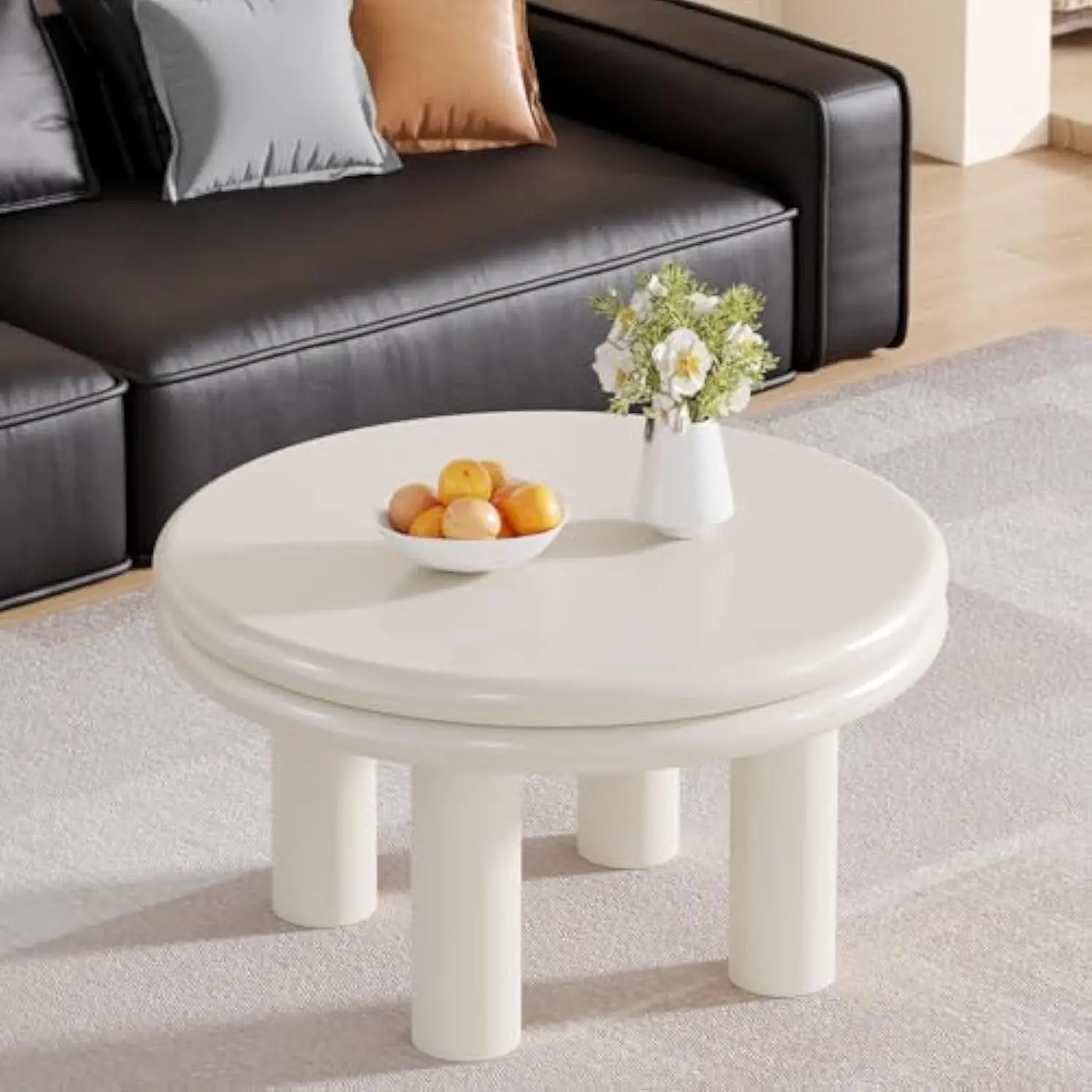
Versatile Scandinavian Side Tables: Compact Solutions with Maximum Impact
Side tables demonstrate the Scandinavian talent for making small pieces highly functional. These compact furnishings maximize utility while maintaining the clean aesthetic that defines Nordic design.
The versatility of side tables appears in their varied forms:
- C-tables slide under sofas to bring surfaces close for working or dining
- Nesting tables stack together to save space but separate for entertaining
- Drum tables offer unexpected storage inside their cylindrical forms
- Tripod tables provide stability with minimal footprints
Smart features enhance their functionality:
- Small, discreet drawers for keeping essentials close at hand
- Multiple tiers that separate different items (drinks on top, books below)
- Lightweight construction that allows easy repositioning
- Durable finishes that withstand drinks, hot items, and daily use
When selecting side tables, consider how they’ll be used. Tables placed beside reading chairs benefit from surface area for lamps and books, while those in conversation areas may prioritize drink space. Materials should stand up to specific uses—water-resistant finishes for drink areas, scratch-resistant surfaces for high-traffic spots.
A well-designed collection of side and end tables complements your main coffee table while extending functionality throughout the room. The principles used when styling black coffee tables apply equally well to integrating side tables into your Scandinavian-inspired living room.
Space-Saving Scandinavian Console Tables: Elegant and Practical Solutions
Console tables exemplify the Scandinavian gift for creating furniture that serves multiple purposes while maintaining a light visual presence. These slender tables maximize functionality in transitional spaces and along walls.
Strategic placement options include:
- Behind sofas to create additional surface without crowding floor space
- Along walls to define circulation paths while providing display area
- Between living zones as subtle room dividers with practical benefits
- In entryways as drop zones for everyday items
Storage features make consoles particularly valuable:
- Narrow drawers perfect for items that would otherwise create clutter
- Open shelving for decorative objects and frequently used items
- Hidden compartments for keeping private items accessible but unseen
Scale considerations are crucial for console tables. Traditional height ranges from 28-30 inches, complementing sofa backs, while depth typically stays between 12-15 inches to maintain slim profiles that don’t intrude into walking paths.
Styling these tables requires balance between function and aesthetics. The Scandinavian approach favors purpose-driven arrangements: a lamp for reading, a tray for keys, perhaps a plant for life, but never so much that the surface becomes cluttered or unusable.
For smaller spaces, nesting table sets can function similarly to console tables when arranged side by side, with the added benefit of separating when extra surfaces are needed.
Clever Scandinavian Nesting and Expandable Tables: Adaptable Design at Its Best
Adaptability represents one of Scandinavian design’s greatest strengths, and nowhere is this more evident than in nesting and expandable tables. These ingenious pieces transform to meet changing needs while maintaining design integrity.
Types of adaptable tables include:
- Nesting sets with 2-3 tables that stack together when not in use
- Extendable surfaces with leaves or panels that pull out for larger gatherings
- Folding components that create additional work areas when needed
- Adjustable heights allowing transitions from coffee to dining positions
The benefits for modern living are substantial:
- Space efficiency in smaller apartments and homes
- Versatility for entertaining unexpected guests
- Accommodation of various activities without dedicated furniture
- Visual consistency that maintains design coherence
Quality construction becomes especially important for tables with moving parts. Solid joinery, precision hardware, and tested mechanisms ensure these pieces function smoothly for years. The simplicity of Scandinavian design actually benefits these complex pieces by reducing unnecessary components that could fail.
When selecting adaptable tables, consider how often you’ll transform them. Daily conversions need more robust mechanisms than occasional changes, and weight should match your ability to move and adjust the pieces comfortably.
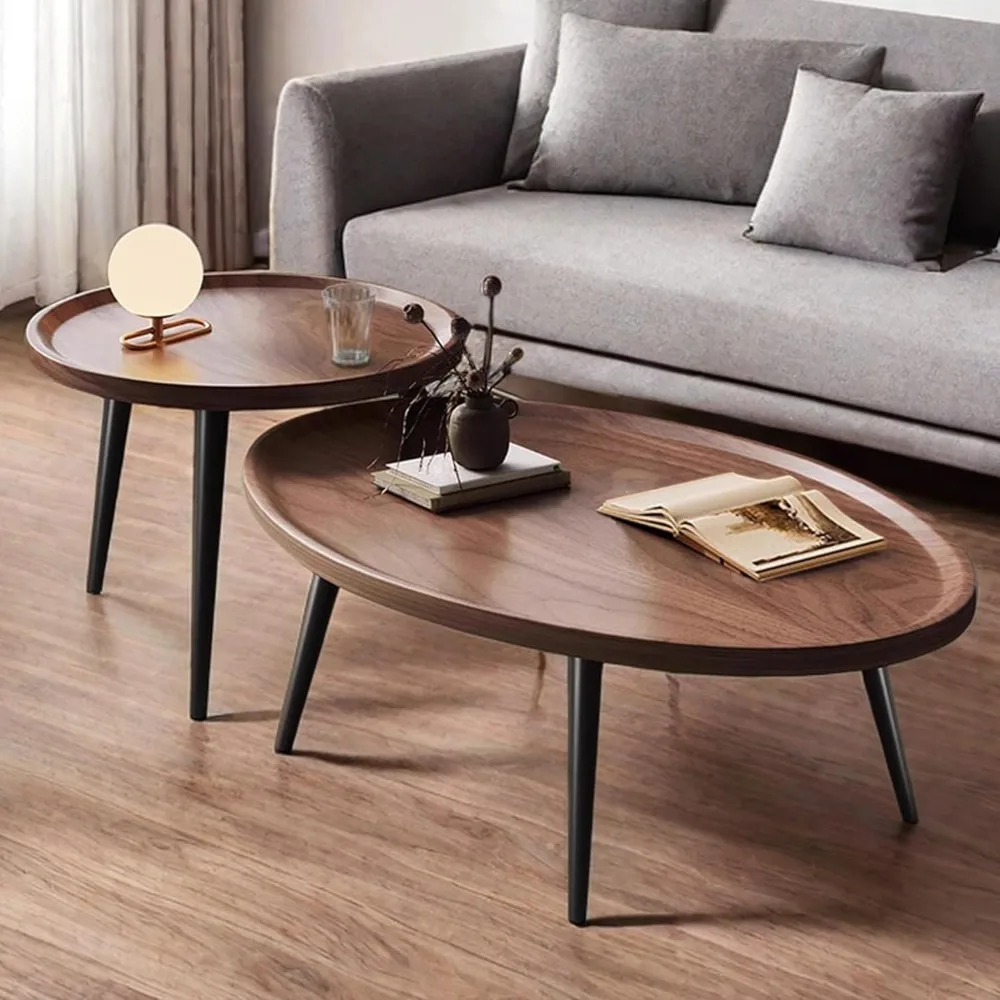
For those with limited space, understanding appropriate coffee table sizes for small living rooms helps select nesting and expandable options that work effectively without overwhelming your space.
Material Selection: Balancing Beauty with Practicality
Material choice significantly impacts both the aesthetic and functional qualities of Scandinavian tables. The right materials create pieces that maintain their beauty despite daily use.
| Material | Aesthetic Benefits | Practical Benefits | Maintenance Considerations |
|---|---|---|---|
| Oak | Prominent grain, warm honey tones | Extremely durable, resists dents | Requires occasional oiling to prevent drying |
| Ash | Light color, straight grain patterns | Flexible yet strong, less prone to splitting | Easily accepts stains for customization |
| Birch | Pale color brightens spaces, subtle grain | Holds detail well, smooth surface | May dent more easily than harder woods |
| Pine | Knotty character, casual warmth | Lightweight, affordable | Softens and develops character marks with use |
| Engineered Wood | Consistent appearance, no warping | Stable in various humidity levels | Requires careful edge treatment |
| Glass | Creates visual lightness, reflects light | Heatproof, easy to clean | Requires regular cleaning to maintain clarity |
| Metal Accents | Adds contrast and definition | Provides structural strength | May conduct heat/cold, consider placement |
Finishes further enhance durability while maintaining the natural beauty of these materials. Traditional Scandinavian approaches favor:
- Clear oils that protect while highlighting wood grain
- Matte lacquers that resist water rings without creating shine
- Soap treatments that create softly weathered appearances
- Natural waxes that build protective patinas over time
Sustainability concerns align perfectly with Scandinavian design ethics. Look for FSC-certified woods, water-based finishes, and construction that allows eventual repair rather than replacement. These considerations echo the same quality features of black coffee tables that make them enduring additions to living spaces.
Integrating Scandinavian Tables into Your Living Space: Practical Tips
Thoughtful placement transforms good tables into great functional elements. Consider these practical guidelines when incorporating Scandinavian tables into your living room:
Maintain proper clearances – Allow 18 inches between coffee tables and seating for comfortable leg room, and ensure at least 30 inches for main walkways around furniture.
Create conversation-friendly arrangements – Position tables where they’re accessible from all seating without requiring people to stand.
Consider scale relationships – Coffee tables should typically be about two-thirds the length of your sofa to create visual balance.
Layer different heights – Combine coffee tables (16-18”), side tables (20-24”), and console tables (28-30”) to create visual interest and functional diversity.
Create purposeful groupings – Arrange tables to serve specific functions (reading corner, conversation area, TV watching zone) rather than randomly distributing them.
Common mistakes to avoid include:
- Oversized tables that restrict movement
- Undersized pieces that create awkward reaching
- Competing styles that create visual tension
- Too many small tables creating a cluttered look
The principles that create a successful minimalist Scandinavian living room apply equally to table selection and placement. Remember that negative space—the empty area around furniture—is as important as the pieces themselves in creating a balanced, functional room.
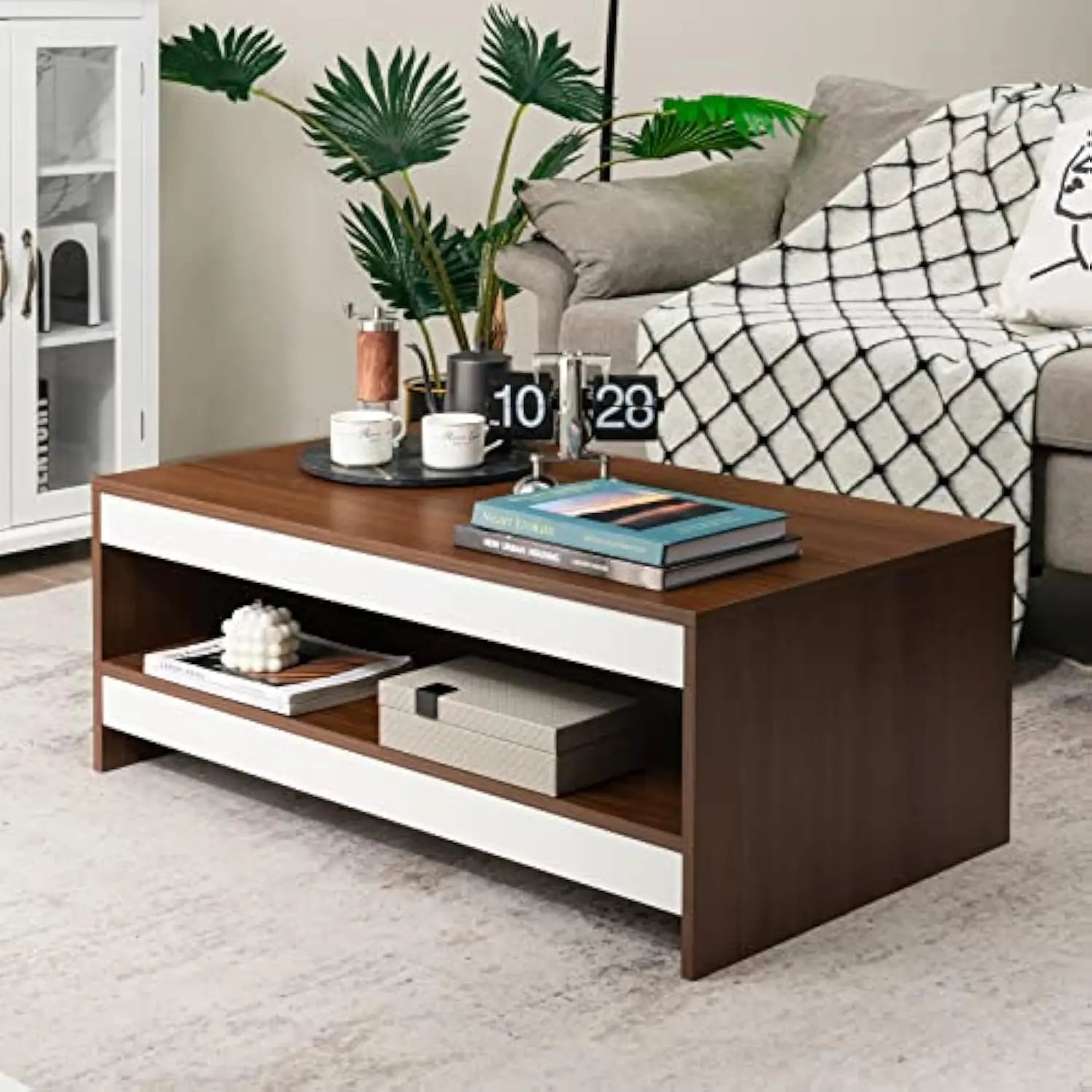
Mid-Century Modern End Table Sets of 2, Mid-Century Modern Square Side & End Tables, Mid-Century Modern White Side & End Tables
$348.24 Select options This product has multiple variants. The options may be chosen on the product pageMid-Century Modern Solid Wood Coffee Tables, Mid-Century Modern Teak Coffee Tables
$879.95 Select options This product has multiple variants. The options may be chosen on the product pageMid-Century Modern Danish Coffee Tables, Mid-Century Modern Oval Coffee Tables, Mid-Century Modern Solid Wood Coffee Tables
$390.05 Select options This product has multiple variants. The options may be chosen on the product pageMid-Century Modern Nesting Side & End Tables, Mid-Century Modern Nesting Table Sets, Mid-Century Modern Round Side & End Tables
Price range: $239.35 through $273.06 Select options This product has multiple variants. The options may be chosen on the product pageMid-Century Modern End Table Sets of 2, Mid-Century Modern Walnut Side & End Tables
Price range: $978.89 through $1,957.38 Select options This product has multiple variants. The options may be chosen on the product pageMid-Century Modern Glass Top Coffee Tables, Mid-Century Modern Glass Top Side & End Tables
$460.58 Select options This product has multiple variants. The options may be chosen on the product page
Are Scandinavian Tables Worth the Investment? Quality Indicators to Consider
Scandinavian tables often command higher prices than mass-produced alternatives, but their value becomes apparent over time. Quality indicators help identify pieces worth investing in:
Construction Quality Checklist
- Solid wood components in structural elements
- Visible joinery like dovetails or mortise-and-tenon connections
- Smooth drawer operation without sticking or excessive play
- Even finish application without drips or thin spots
- Consistent leg attachment with no wobbling
- Balanced weight distribution that prevents tipping
- Smooth edges and corners, properly sanded and finished
Quality Scandinavian designs typically feature wood thickness appropriate to the piece’s function—substantial enough for stability but not overbuilt, which would contradict the light aesthetic. Hardware should be discreet yet sturdy, often featuring brass or stainless steel components that resist corrosion.
When evaluating price points, consider that true Scandinavian design values longevity. A well-made table might cost more initially but will serve for decades rather than requiring replacement after a few years. At Hearth Forms, each piece is selected for its authentic design details and quality construction that honors these traditions.
How Do You Maintain the Beauty of Scandinavian Tables Over Time?
Proper care ensures your Scandinavian tables remain beautiful for generations:
Daily Care Basics
- Use coasters for hot and cold drinks
- Dust with soft, lint-free cloths
- Clean spills immediately to prevent staining
- Lift objects rather than dragging them across surfaces
- Rotate decorative items periodically to prevent uneven aging
Material-Specific Maintenance
- Wood surfaces: Apply appropriate oil or wax treatments seasonally
- Glass components: Clean with non-ammonia glass cleaners
- Metal elements: Wipe with slightly damp cloth and dry immediately
For common issues like water rings on wood, try gentle removal methods like mayonnaise left overnight before resorting to refinishing. Minor scratches in light woods can often be diminished by rubbing with a walnut half, allowing its oils to fill the damaged area.
Seasonal maintenance should include checking and tightening any loose connections, particularly in tables with moving parts. This preventative care helps avoid more significant problems and ensures your tables function properly for years to come.
Can Scandinavian Tables Work in Non-Scandinavian Interior Styles?
The beauty of Scandinavian tables lies in their remarkable versatility across design styles. Their clean lines and natural materials create bridges between different aesthetic approaches:
In contemporary interiors, Scandinavian tables add warmth and texture that softens modern minimalism. The organic qualities of wood counterbalance the coolness often found in contemporary spaces.
Traditional settings benefit from Scandinavian tables’ simplicity, which can prevent rooms from feeling overly ornate or heavy. These pieces create breathing space among more detailed furnishings.
Eclectic rooms find coherence through Scandinavian tables that act as neutral foundations. Their understated presence allows more expressive pieces to shine while providing functional surfaces that don’t compete visually.
Industrial spaces gain softness and approachability when paired with Scandinavian wood tables. The contrast between raw materials like concrete or exposed brick and refined wooden surfaces creates compelling visual tension.
This adaptability explains why certain design combinations work so harmoniously, as explored in our guide to styles that complement mid-century modern furniture.
Summary: Creating Your Functional Scandinavian Living Room with the Right Tables
Scandinavian table design offers the perfect solution for today’s multi-functional living rooms by harmoniously blending beauty with practicality. The core principles—clean lines, quality materials, and human-centered proportions—create pieces that enhance daily living rather than simply decorating space.
From coffee tables that center your living area to adaptable nesting sets that transform with your needs, each table type serves specific functions while maintaining visual cohesion. The thoughtful material selection, construction quality, and proportional awareness that define Scandinavian design ensure these pieces remain relevant and beautiful for years.
As you create your own functional living space, remember that true Scandinavian design values purpose, quality, and simplicity. Tables should serve your lifestyle needs while bringing beauty into everyday moments. By selecting pieces with these principles in mind, you’ll create a living room that feels both timeless and perfectly suited to modern life.

